"Shinboshi (The loadstar)"
Gallery Cellar, Tokyo
October 28 [Wed] - November 14 [Sat], 2009 closed on Sundays, Mondays, National Holidays
12:00 - 18:00
Reception October 28 [Wed] 17:00 - 19:00
「心星」
ギャラリーセラー、銀座
2009年10月28日 (水) 〜 11月14日 (土) 日/月/祝日 休廊
12:00 〜 18:00
レセプション 10月28日 (水) 17:00 〜 19:00
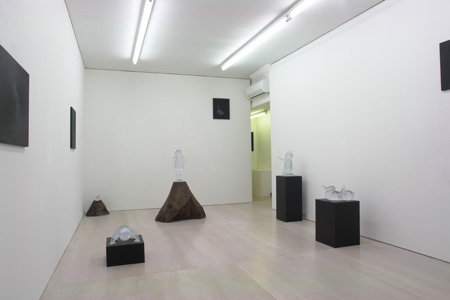
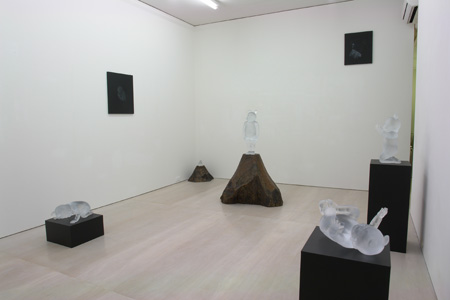
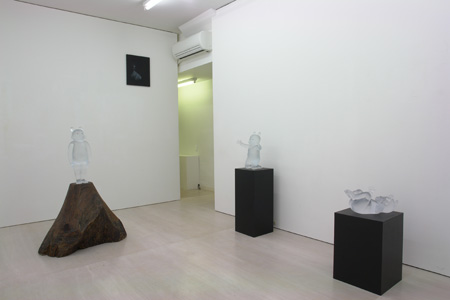
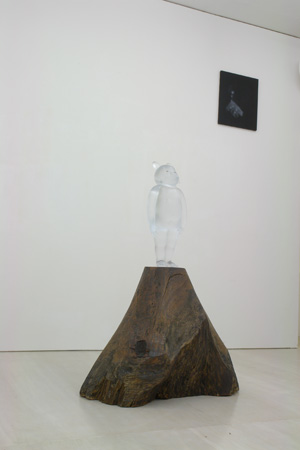
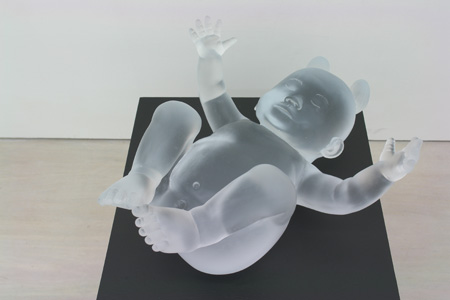
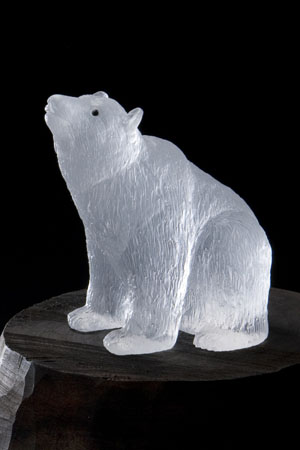
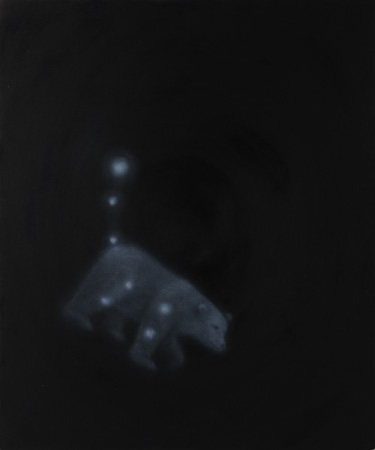

Text from Matsufuji Koichi “ Shinboshi ” at Gallery Cellar in 2009
This exhibition brings us back to the beginning of human kind like infants and sends us off on a journey toward the infinite, chaotic time and space, in search beyond the universe of the spiritual pointer that, as a life phenomenon, surpasses the phenomenon. The directivity of Koichi Matsufuji remains the same for this exhibition, which is entitled Shinboshi to signify the North Star that guided sea navigation since ancient times; and it looks like this directivity of his is going to become more radical. After encountering his glass baby at the Aichi Prefectural Museum of Art in 2008, I introduced his work in an article in the Nikkei (November 27, Nagoya evening edition) as follows.
The seven semi-clear frosted-glass babies display individual poses as they sit scattered on the floor and display mounts. There is an air about Koichi Matsufuji’s exhibition, The Brimming Universe that lures the viewer to surrender.
As light shines over the bodies of these babies, you can almost see through the inside of them. They seem to nullify their presence to assimilate with their surroundings, quietly emitting a glow as they respire, as if to spread that glow indomitably. The effect is one that makes the entire exhibition room seem like the interior of a human body, or makes the visitor feel as if he has entered inside these babies.
With various possibilities to face the worlds of these seven sculptures deciphered through their expressions and poses, one can sense the fundamental way of human beings which is sandwiched between being part of any of such worlds and yet not belong to any of them. The bunches of hair that appear like the ears of mammals might be hinting at the equality of humans and animals, while the silver butterflies attached to their skin may indicate the association between humans and the world.
The “Seated baby of chu-cho” who looks up, the “Seated baby of chu-so” that looks down in pensive mode, the “Lying baby of chu-wa” who lies willfully, or the “Seated babies of chu-yu” (set of two babies) who sit as if levitating all incorporate a myriad aspects of connections to the world. One of the central foci is the upward gaze in pensive mode, showing the intersecting of the gaze toward the exterior with the consciousness of the interior; while another central focus is the duality of living organisms on planet Earth that, while submitting to gravity, attempts to break free. These sculptures bring together human movements and consciousness in their primitive form.
As the beginning of human kind is seen through the simple poses of these babies, we can detect in the adult-like fixed gazes and facial expressions the degree of earnest inner self-reflection. There also seems to be a secret in the ingenuity of the combining of child and adult.
From this exhibition one was able to sense directly the necessity of the “spiritual pointer that, as a life phenomenon, surpasses the phenomenon” in order to resolve social anxiety one may feel due to the loss of oneself; it also allowed one to feel that, more than for inheriting traditionally crafting techniques passed down from ancient times, it would be effective for the establishment of the spiritual structure of future generations created through visualization. What might the latest work of the standing baby gazing up at the heavens from mountaintop be telling us?
Hideki Nakamura
Art Critic
2009年 松藤孝一「心星」展のカタログより
赤ちゃんのように人間の原点に立ち返って無限なるカオスの時空と向き合い、生命現象のまま現象を超える心の指針を宇宙の彼方に求める。松藤孝一のその方向性は、昔から航海の目印であった北極星を意味する「心星」がタイトルとなる今回の展覧会でも変わらず、さらに先鋭化しそうだ。彼のガラスの赤ちゃんと2008年に愛知県美術館で初めて出会った私は、「日本経済新聞」(11月27日付夕刊、名古屋版)に次のように紹介した。
半透明のすりガラスで出来た七体の赤ちゃんがそれぞれの仕草を示しながら、展示室内あちこちの床面や台の上に配されている。松藤孝一のテーマ展「湛(たた)える宙(そら)」には、見る人がそこに身を委ねたくなるような空気が漂う。
光に照らされた赤ちゃんの全身は、体内がやや透き通って見え、自らを無にして周囲に同化するようでもあり、静かに光を放って息づき、たくましく広がろうとするようでもある。展示室内全体が人体の内部であるかに、また、自分が赤ちゃんのうちに入り込んだかにも思われてくる。
表情や姿勢から読み取れる、七体の世界との向き合い方は様々で、それらのどれでもあり、どれでもない狭間に、人間本来のあり方が感じられる。哺乳類の耳に似た束髪は人と動物の等しさを、皮膚にまつわり付く銀蝶は人と世界の交わりを暗示するのか。
上を見上げる「宙眺赤子坐像」や、目を落として考える「宙想赤子坐像」、気ままに横たわる「宙和赤子寝像」、宙に浮くように腰かける「宙遊赤子坐像」(二体で一組)といった各作品には、世界との関係の多様な側面がちりばめられている。その一つの中心は、見上げ考え込む、外部への目と内部の意識との交錯であり、もう一つは、重力に身を任せながら、それから自由になろうとする地球上の生き物の両面である。人間の動作と意識の原形が集約されている。
赤ちゃんの素朴な仕草に人間の始原が見いだされると同時に、見据えるようなその大人びた目つきや顔立ちに内面的な自省の深さがうかがわれる。子供と大人の複合にも巧みさの秘密がありそうだ。
以上の展示からは、〈生命現象のまま現象を超える心の指針〉が自己喪失による社会不安の解決に不可欠なことと、古くから受け継がれた工芸的な技法が伝統的様式の継承よりも、視覚的対象化による次世代の精神構造の確立に有効なことが直感される。山の上から天を見つめる最新作の赤ちゃん立像は、私たちに何を語りかけるのだろうか。
美術評論家 中村英樹
© Koichi Matsufuji, All rights reserved